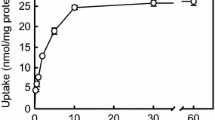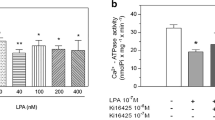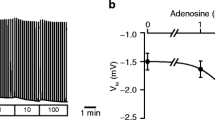Abstract
Extracellular nucleotides, acting through P2-purinoceptors, have been implicated in the regulation of ion transport in epithelia, including Madin-Darby canine kidney (MDCK) cells. In this study, experiments were conducted to characterize the P2-purinoceptor subtype on MDCK cells responsible for stimulating inositol phosphate (IP) accumulation using a range of nucleotide analogues. In Ca2+- and Mg2+-free Krebs-Henseleit solution (KHS), ATP, UTP, and ATPγS caused an increase in IP accumulation as a function of concentration with comparable kinetics. The order of potency for the nucleotide analogues was UTP = ATPγS > ATP = 2-chloro ATP (Cl-ATP) >> α,β-methylene ATP (α,β-MeATP) = 2-methylthio ATP (2MeSATP). Selective agonists for P1-, P2X- and P2Y-purinoceptors, such as N6-cyclopentyl adenosine, AMP, α,β-MeATP, and 2MeSATP, had little effect. Stimulation of MDCK cells with maximally effective concentrations of ATP and UTP showed no additive effect and furthermore, ATP, UTP, and ATPγS induced cross-desensitization of the IP response, suggesting that ATP and UTP act upon a common nucleotide receptor, i.e. a P2U-purinoceptor. In Ca2+- and Mg2+-containing KHS, the concentration-response curves of ATP, UTP, and ATPγS were shifted to the right of those obtained in Ca2+- and Mg2+-free buffer, and asymptotic maxima were not reached, indicating that ATP4- and not MgATP2- or CaATP2- was the active agonist. Pretreatment of MDCK cells with pertussis toxin (PTX) inhibited ATP- and UTP-induced IP accumulation in a concentration-dependent fashion but did not completely abolish the IP accumulation, indicating that a PTX-sensitive G protein was partially involved in the IP response. In conclusion, ATP- and UTP-stimulated IP accumulation in MDCK cells appears to be mediated through the activation of P2U-purinoceptors coupled to a G protein that is partially sensitive to PTX. A form of nucleotide uncomplexed with divalent ions such as ATP4- seems to be the preferential agonist form for the purinoceptors on MDCK cells.
Similar content being viewed by others
Author information
Authors and Affiliations
Additional information
Received: 25 June 1996 / Accepted: 4 April 1997
Rights and permissions
About this article
Cite this article
Yang, CM., Tsai, YJ., Pan, SL. et al. Purinoceptor-stimulated phosphoinositide hydrolysis in Madin-Darby canine kidney (MDCK) cells. Naunyn-Schmiedeberg's Arch Pharmacol 356, 1–7 (1997). https://doi.org/10.1007/PL00005015
Issue Date:
DOI: https://doi.org/10.1007/PL00005015




